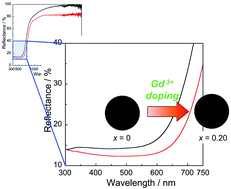Novel near-infrared reflective black inorganic pigment based on cerium vanadate
Abstract
Gd3+-doped cerium vanadates, Ce1−xGdxVO4 (0 ≤ x ≤ 0.30), were synthesized as near-infrared (NIR) reflective black pigments by a conventional solid-state reaction method. Crystal structure, particle size, optical properties, and color of the samples were characterized. The Ce1−xGdxVO4 (0 ≤ x ≤ 0.30) samples were obtained in a single-phase form and the lattice volume decreased with increasing Gd3+ concentration. Optical absorption below 630 nm was observed in all samples, which corresponded to the charge-transfer transition between Ce4f and V3d orbitals. The absorption spectrum of Ce1−xGdxVO4 was shifted to the longer wavelength side as the Gd3+ content increased, because of the increase in the crystal field around V5+ due to the lattice shrinkage. As a result, the sample color gradually changed from dark brown to black with increasing Gd3+ content. Among the samples synthesized in this study, Ce0.80Gd0.20VO4 absorbed visible light with wavelengths shorter than 650 nm and exhibited the darkest color. Furthermore, this black pigment showed a sufficient NIR reflectance value (R = 66.3%), which was higher than those of the commercially available products (R < 50%).



 Please wait while we load your content...
Please wait while we load your content...